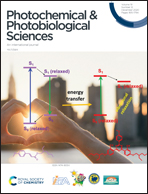Competition between fluorescence and triplet production ruled by nitro groups in one-arm and two-arm styrylbenzene heteroanalogues†
Abstract
The competition between excited state deactivation processes in mono and double-arm push–pull systems bearing pyridine, furan or thiophene (electron donors) and nitro groups (electron acceptors) was investigated in several solvents through nanosecond and femtosecond transient absorption spectroscopy. Triplet population is the main deactivation pathway for the mono-arm compounds. The large triplet production is mainly ascribed to 3(n,π*) states almost isoenergetic to S1, introduced by nitro groups, as predicted by TD-DFT calculations. The large triplet population may indeed be exploited to produce long-lived excitons for photovoltaic and optoelectronic applications. Two-arm furan and thiophene derivatives instead undergo strong ultrafast intramolecular charge transfer (ICT), which is responsible for their appreciable two-photon absorption cross-sections. In this case, significant fluorescence and singlet oxygen quantum yields are obtained, making these two compounds interesting as potential traceable photosensitizers in photodynamic therapy.



 Please wait while we load your content...
Please wait while we load your content...